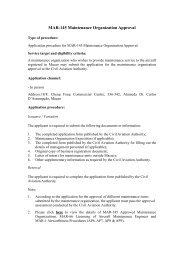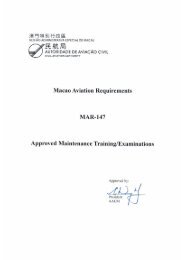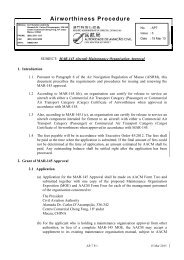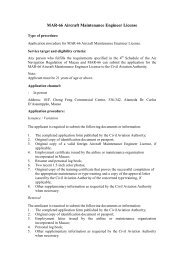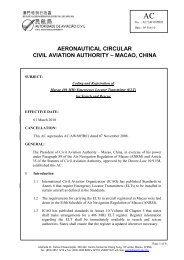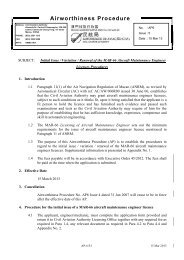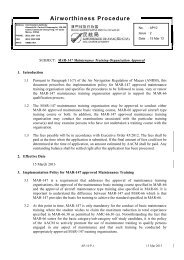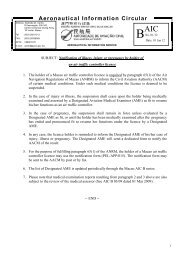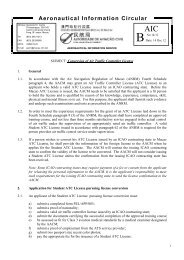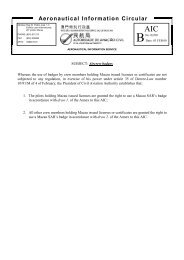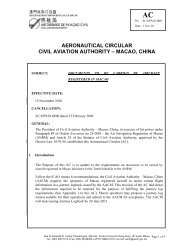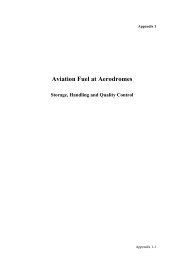Mandatory Occurrence Reporting Scheme
Mandatory Occurrence Reporting Scheme
Mandatory Occurrence Reporting Scheme
You also want an ePaper? Increase the reach of your titles
YUMPU automatically turns print PDFs into web optimized ePapers that Google loves.
AC<br />
No. : AC/GEN/003R02<br />
Date : 24 June 2013<br />
AERONAUTICAL CIRCULAR<br />
CIVIL AVIATION AUTHORITY – MACAO, CHINA<br />
SUBJECT:<br />
<strong>Mandatory</strong> <strong>Occurrence</strong> <strong>Reporting</strong> <strong>Scheme</strong><br />
EFFECTIVE DATE:<br />
01 July 2013<br />
CANCELLATION:<br />
This AC supersedes AC no. AC/GEN/003 R01 dated 14 March 2011.<br />
GENERAL:<br />
Paragraph 88 of the Air Navigation Regulation of Macao (ANRM) approved by the<br />
Executive Order 8/2011 specifies the provision under which a person(s) shall made a<br />
report to the Civil Aviation Authority (AACM) of any reportable occurrence. The<br />
President of AACM, in exercise of his power under Article 35 of the Statutes of AACM<br />
approved by the Decree-Law 10/91/M and Paragraph 89 of the ANRM establishes this<br />
AC to define in detail the AACM <strong>Mandatory</strong> <strong>Occurrence</strong> <strong>Reporting</strong> (MOR) <strong>Scheme</strong> and<br />
provide guidance to those who are involved in its operation.<br />
1 Introduction<br />
The objectives of the AACM MOR <strong>Scheme</strong> are as follows:<br />
(a) To ensure that the AACM is advised of hazardous or potentially hazardous<br />
incidents and defects (hereafter referred to as occurrences);<br />
(b) To enable knowledge of these occurrences to be disseminated so that other<br />
persons and organisations may learn from them;<br />
(c) To enable an assessment to be made by those concerned (whether inside or<br />
outside the AACM) of the safety implications of each occurrence, both in itself<br />
and in relation to previous similar occurrences, so that they may take or initiate<br />
any necessary action.<br />
The overall objective of the AACM in operating occurrence reporting is to use the<br />
reported information to improve the level of flight safety and not to attribute blame. All<br />
Alameda Dr. Carlos D’Assumpção, 336-342, Centro Comercial Cheng Feng, 18º andar, Macau, CHINA<br />
Tel.: (853) 2851 1213 • Fax: (853) 2833 8089 • AFTN: VMMCYAYI • E-mail: aacm@aacm.gov.mo<br />
Page 1 of 7
AC<br />
No. : AC/GEN/003R02<br />
Date : 24 June 2013<br />
the information contained in organization’s Internal <strong>Occurrence</strong> <strong>Reporting</strong> Systems<br />
(IORS) and the AACM MOR scheme are applicable to the requirements and basic<br />
principles of the processing and protection of aviation safety information defined under<br />
the Law no. 2/2013 Civil Aviation Accident and Incident Investigation and Aviation<br />
Safety Information Protection Law and protective measures defined under Aeronautical<br />
Circular no. AC/GEN/010 Safety Information Protection.<br />
2 Applicability<br />
2.1 The scope of the AACM MOR <strong>Scheme</strong> includes all reportable occurrences (see 2.2<br />
below) involving:<br />
(a) any aircraft registered in Macao Special Administrative Region (SAR);<br />
(b) any aircraft operating under the jurisdiction of a Macao SAR operator (e.g.<br />
leased aircraft); and<br />
(c) organisations providing a service or facility for aircraft operating in the Macao<br />
SAR or Macao SAR Air Traffic Zone (ATZ) regardless of the nationality of the<br />
aircraft involved.<br />
2.2 “Reportable <strong>Occurrence</strong>” means:<br />
(a) any incident relating to an aircraft or any defect in or malfunctioning of an<br />
aircraft or any part or equipment of an aircraft, being an incident,<br />
malfunctioning or defect endangering, or which if not corrected would<br />
endanger, the aircraft, its occupants, or any other person;<br />
(b) any defect in or malfunctioning of any facility on the ground, used or intended<br />
to be used for purposes of or in connection with the operation of an aircraft,<br />
being a defect or malfunctioning endangering, or which if not corrected would<br />
endanger, the aircraft or its occupants; and<br />
(c) any incident relating to a violation of any regulation or procedures of any<br />
country or territory in which such an aircraft operates;<br />
Provided that any accident notified to the AACM shall not constitute a reportable<br />
occurrence for the purposes of this document.<br />
2.3 A report should also be submitted on any occurrence, which involves, for example,<br />
a defective condition, unsatisfactory behaviour or procedure, which did not<br />
immediately endanger the aircraft, but which if allowed to continue uncorrected or<br />
which, if repeated in different, but likely, circumstances, would create a hazard.<br />
Note 1: A list of reportable occurrences can be found in Appendix 2.<br />
3 Report Responsibility<br />
3.1 The following categories of persons or organisations are required to report:<br />
Alameda Dr. Carlos D’Assumpção, 336-342, Centro Comercial Cheng Feng, 18º andar, Macau, CHINA<br />
Tel.: (853) 2851 1213 • Fax: (853) 2833 8089 • AFTN: VMMCYAYI • E-mail: aacm@aacm.gov.mo<br />
Page 2 of 7
AC<br />
No. : AC/GEN/003R02<br />
Date : 24 June 2013<br />
(a) operator, owner and pilot in command of those aircraft stated in Paragraph 2.1<br />
(a) and (b);<br />
(b) those concerned with the designing, manufacturing repairing, maintaining and<br />
overhauling of such aircraft, or any part or item of equipment intended for use<br />
on such an aircraft;<br />
(c) those who sign Certificates of Maintenance Review and Release to Service for<br />
such aircraft, or any part or item of equipment; and<br />
(d) the directors of Macao International Airport or Macao Heliport (see Note 2).<br />
Note 2: The Airport/Heliport Director must report to the AACM any occurrence, even when there<br />
is no direct involvement with aircraft, with all the available details as complete as possible.<br />
3.2 It should be understood that this paragraph defines those who have to report,<br />
anyone may in fact report should they consider it necessary.<br />
4 <strong>Reporting</strong> Procedure<br />
4.1 The AACM encourages the use of company reporting systems, with a responsible<br />
person(s) within the organisation being nominated to receive all reports from<br />
individuals and to establish which reports within the organisation meet the desired<br />
criteria for an occurrence report to the AACM. However, the company must tell<br />
the employee who made the report if his/her report has been passed on to the<br />
AACM or not. If not, and the employee is convinced that it should, he/she must<br />
have the right to insist that the report is passed to the AACM or to report it<br />
directly to the AACM himself/herself. Procedures to ensure that this right of the<br />
individual reporter is maintained must be incorporated into the organisation’s<br />
reporting procedures and be clearly stated in the relevant instructions to staff.<br />
4.2 In the case of occurrences arising from or relating to faults, malfunctions or<br />
defects that might cause adverse effects on the continuing airworthiness of the<br />
aircraft, the organisation which raises the occurrence report must pass a copy of<br />
the report to the appropriate type design holder and manufacturer(s) of the<br />
relevant products. Where a continuing airworthiness safety issue is associated<br />
with a modification, the organisation which raises the occurrence report must also<br />
pass a copy of the report to the organisation responsible for the design of the<br />
modification.<br />
4.3 Individuals submitting an occurrence report directly to the AACM, in the interest<br />
of flight safety, are strongly advised to notify their employers, preferably by a<br />
copy of the report, unless confidentiality is considered essential. When<br />
appropriate, the employer in turn should then advise the type design holder or<br />
equipment manufacturer(s) of the products.<br />
4.4 Reports must be dispatched within 72 hours of the event, unless exceptional<br />
circumstances prevent this. Nevertheless, when the circumstances of an<br />
Alameda Dr. Carlos D’Assumpção, 336-342, Centro Comercial Cheng Feng, 18º andar, Macau, CHINA<br />
Tel.: (853) 2851 1213 • Fax: (853) 2833 8089 • AFTN: VMMCYAYI • E-mail: aacm@aacm.gov.mo<br />
Page 3 of 7
AC<br />
No. : AC/GEN/003R02<br />
Date : 24 June 2013<br />
occurrence are judged to be particularly hazardous or urgent, the AACM expects<br />
to be advised of the essential details by the fastest possible means (e.g.<br />
telex/fax/telephone). This should be followed up within 72 hours by a full written<br />
report to the AACM with appropriate copies as per para 4.2 and 4.3 above. The<br />
AACM is dependent upon the judgment of those responsible for submitting<br />
reports to establish which occurrences are in this category.<br />
4.5 Should the initial report be incomplete in respect of any item of information<br />
required, a further report containing this information must be made within 72<br />
hours of the information becoming available.<br />
4.6 Particularly in the case of technical failures or difficulties, the availability of<br />
photographs and/or damaged parts will greatly facilitate the subsequent<br />
investigation. Prompt advice to the AACM on the results of investigations and<br />
the actions taken to control the situation will minimise or may render unnecessary<br />
AACM’s direct involvement in the investigation activity.<br />
4.7 A manufacturer or maintenance organisation of aircraft, components or equipment<br />
is not expected to report to the AACM, as a matter of routine, those occurrences<br />
involving products which have been reported to it by an operator/individual, if the<br />
operator/individual has already reported the occurrence to the AACM. The<br />
primary duty for reporting in such cases will rest with the operator/individual.<br />
Manufacturers, etc. should report any such occurrence which they think is<br />
reportable as per the guidance given above if they know that the operator<br />
concerned has not done so.<br />
4.8 If any reporter considers that it is essential that his/her identity is not revealed, the<br />
report itself should be clearly annotated ‘CONFIDENTIAL’ and submitted<br />
directly to the President of AACM with the envelope marked as ‘PERSONAL’.<br />
The request will be respected and the reporter will be contacted personally.<br />
5 <strong>Reporting</strong> Forms<br />
5.1 To facilitate consistent reporting, subsequent storage and analysis of data, Form<br />
AACM-AW-6 (see Appendix 1) should be used in mandatory occurrence<br />
reporting except the cases stated in 5.2, 5.3 and 5.4. However, organisations may<br />
wish to use a reporting form designed to meet their own requirements. In such<br />
cases the ‘in house’ document(s) should as far as possible follow the general<br />
format of the AACM-AW-6 and be approved by the AACM.<br />
5.2 In case of proximity of two aircraft, by which one or both pilots involved feel<br />
endangered (AIRPROX) or in case of other serious problems which may endanger<br />
the flight (erroneous procedures and/or non-observance of procedures or failure of<br />
ground stations), the pilot(s) shall fill in the “Air Traffic Incident Report Form” in<br />
accordance with the procedures set forth in the Macao AIP.<br />
Alameda Dr. Carlos D’Assumpção, 336-342, Centro Comercial Cheng Feng, 18º andar, Macau, CHINA<br />
Tel.: (853) 2851 1213 • Fax: (853) 2833 8089 • AFTN: VMMCYAYI • E-mail: aacm@aacm.gov.mo<br />
Page 4 of 7
AC<br />
No. : AC/GEN/003R02<br />
Date : 24 June 2013<br />
5.3 In case of bird strike, a “Bird Strike <strong>Reporting</strong> Form” shall be filled in by the<br />
operator and/or relevant airport/heliport department in accordance with the<br />
procedures set forth in the Aeronautical Circular no. AC/AGA/004 Bird Strike<br />
<strong>Reporting</strong>. Submission of Form AACM-AW-6 “<strong>Occurrence</strong> Report” is required<br />
only when the bird strike resulted in significant damage to the aircraft or loss or<br />
malfunction of any essential service.<br />
5.4 In the case of runway incursion, “Runway Incursion <strong>Reporting</strong> (Initial Report)”<br />
Form (see Appendix 3) shall be filled. Submission of Form AACM-AW-6<br />
“<strong>Occurrence</strong> Report” for this particular event is no longer required.<br />
5.5 Form AACM-AW-6 “<strong>Occurrence</strong> Report” and “Runway Incursion <strong>Reporting</strong><br />
(Initial Report)” Form are available for download from the AACM website<br />
www.aacm.gov.mo.<br />
6 Notification<br />
6.1 Completed reporting form is to be addressed to:<br />
The President<br />
Civil Aviation Authority<br />
Alameda Dr. Carlos D’Assumpção, 336-342,<br />
Centro Comercial Cheng Feng, 18º andar,<br />
Macau<br />
6.2 In some cases – particularly overseas or emergency – the use of AFTN, fax, e-<br />
mail or even telephone may be necessary to minimise delays in the transmission<br />
of occurrence information.<br />
Telephone : AACM Office (853) 2851 1213<br />
Emergency Hotline (853) 6232 2999<br />
Fax : (853) 2833 8089<br />
E-mail : aacm@aacm.gov.mo<br />
AFTN : VMMCYAYI<br />
7 Investigation<br />
7.1 Normally, if the root cause of the reportable occurrence has not been identified,<br />
the relevant organization(s) is required to conduct an investigation to the<br />
occurrence and provide AACM an investigation report within three months from<br />
the date of occurrence. If necessary, the AACM can request the relevant<br />
organisation(s) to submit a preliminary investigation report within one month<br />
from the date of occurrence. The organisation(s) shall take any immediate<br />
action(s) to detect and avoid similar case from happening again. A reportable<br />
Alameda Dr. Carlos D’Assumpção, 336-342, Centro Comercial Cheng Feng, 18º andar, Macau, CHINA<br />
Tel.: (853) 2851 1213 • Fax: (853) 2833 8089 • AFTN: VMMCYAYI • E-mail: aacm@aacm.gov.mo<br />
Page 5 of 7
AC<br />
No. : AC/GEN/003R02<br />
Date : 24 June 2013<br />
occurrence is considered closed by the AACM only if the root cause has been<br />
identified and the corrective and/or preventive actions taken are considered<br />
appropriate.<br />
7.3 The AACM reserves the right to conduct an individual investigation to an incident<br />
(other than accident and serious incident stated in Paragraph 7.3). The decision of<br />
whether to conduct an investigation and how detailed the investigation is<br />
depending on the nature and significance of the incident.<br />
7.3 According to Law no. 2/2013 and the Annex 13 to the Convention on<br />
International Civil Aviation, the AACM shall institute an investigation into the<br />
circumstances of an accident and serious incident occurred in Macao SAR or<br />
within the airspace under Macao SAR jurisdiction. It is also stated in Article 8 no.<br />
2 of Law no. 2/2013 that AACM can investigate an incident, if AACM considers<br />
that the investigation can facilitate collection of information and gain experience<br />
in regard to aviation safety. Therefore all information regarding occurrence<br />
received through the MOR <strong>Scheme</strong> will be passed to the Investigator in Charge<br />
(IIC) for investigation purpose according to Annex 13 standards and AACM<br />
Aeronautical Circular no. AC/GEN/002 Rules Concerning Aeronautical Accidents<br />
and Incidents.<br />
8 Retention of Data from a Flight Data Recorder (FDR)<br />
8.1 Following a serious incident, the operator(s) is/are required to retain the data from<br />
the flight data recorder (FDR) only if the data contained therein is considered<br />
useful for investigation. Examples of incidents for which data from FDR would be<br />
most useful are: significant excursion from the intended flight parameters;<br />
significant loss of control or control difficulties; unexpected loss of performance;<br />
and a genuine warning from the Ground Proximity Warning System (GPWS).<br />
However, more comprehensive recorders fitted to some aircraft are capable of<br />
providing valuable data on a wider range of occurrences and the AACM would<br />
expect to make judicious use of such information in relation to appropriate<br />
occurrences.<br />
8.2 For this purpose, the AACM requests that operators retain the data from an FDR or<br />
other recorders which is relevant to a reportable occurrence for a period of 14<br />
days from the date of the occurrence being reported to the AACM, or a longer<br />
period if the AACM so requests.<br />
8.3 The AACM is dependent upon the judgment of those responsible for submitting<br />
reports to establish which occurrences require the retention of FDR data. It is<br />
equally incumbent upon the AACM to advise the reporting organisation as<br />
quickly as possible when it requires such data.<br />
9 Processing of <strong>Occurrence</strong> Reports<br />
Alameda Dr. Carlos D’Assumpção, 336-342, Centro Comercial Cheng Feng, 18º andar, Macau, CHINA<br />
Tel.: (853) 2851 1213 • Fax: (853) 2833 8089 • AFTN: VMMCYAYI • E-mail: aacm@aacm.gov.mo<br />
Page 6 of 7
AC<br />
No. : AC/GEN/003R02<br />
Date : 24 June 2013<br />
9.1 After receiving of an occurrence report, the AACM has the following<br />
responsibilities:<br />
- Evaluation in order to identify those occurrences considered to require<br />
AACM involvement in follow-up and to direct these to the appropriate<br />
specialist division(s) within the AACM for action. Such reports are<br />
classified as ‘Open’. All reports not requiring AACM follow-up are<br />
recorded as ‘Closed’ by the responsible division(s);<br />
- Coordinating, monitoring and progressing to satisfactory closure the AACM<br />
follow-up on an ‘Open’ occurrence;<br />
- Dissemination of occurrence information to those who need to know, and<br />
other authorities, such as the state of design authority;<br />
- Continuously monitoring all incoming data for significant hazards or<br />
potential hazards by using previously stored data when appropriate. Alerting<br />
corresponding AACM specialist divisions and others as necessary; and<br />
- Regular monitoring of stored data to identify hazards or potential hazards.<br />
9.2 <strong>Occurrence</strong>s Closed on Receipt by AACM - In some occasions, occurrences<br />
reported to the AACM while meeting the criteria for a reportable occurrence, have<br />
been adequately dealt with by the reporting organisation. There is thus no<br />
justification for further investigation by the AACM although details of the<br />
occurrence and action taken do provide valuable information for dissemination<br />
and storage purposes. Reports judged to be in this category are ‘Closed on<br />
Receipt’ by the appropriate division, the principal justification for closure being<br />
that it is evident from the report that existing requirements, procedures,<br />
documentation, etc. coupled with the reporter’s action have adequately controlled<br />
the identified hazard. When necessary, the responsible division will liaise with the<br />
reporter in making this decision.<br />
9.3 The ability of the AACM to close an occurrence on receipt and thus avoid the<br />
need for further AACM investigation is therefore very much dependent upon the<br />
quality of the information provided in the report and specific information on the<br />
action taken by the reporting organisation to control the situation.<br />
- END -<br />
Alameda Dr. Carlos D’Assumpção, 336-342, Centro Comercial Cheng Feng, 18º andar, Macau, CHINA<br />
Tel.: (853) 2851 1213 • Fax: (853) 2833 8089 • AFTN: VMMCYAYI • E-mail: aacm@aacm.gov.mo<br />
Page 7 of 7
Appendix 1<br />
Instructions on the Completion of the AACM-AW-6 Form<br />
1. General<br />
1.1 Wherever possible, reporters should complete all sections of the Form where the<br />
information requested is relevant to a specific occurrence; relevance is the important<br />
aspect and where any of the information requested is clearly not relevant it may be<br />
omitted, e.g. weather details when weather is not a factor.<br />
1.2 The individual ‘box’ headings for all items of data are mostly self-explanatory, and the<br />
Form comprises a combination of blank boxes for entry of data and boxes listing a<br />
number of alternatives: the reporter should annotate the appropriate item.<br />
2. Instructions for AACM-AW-6 Users<br />
2.1 Spaces for ‘Date received’ and ‘<strong>Occurrence</strong> No.’ at the top of the Form are for AACM<br />
use only.<br />
2.2 The Form is arranged such that types of occurrence are grouped under three categories:<br />
- Air Traffic Related;<br />
- Aerodrome & Facilities Related;<br />
- Flight Operations and Airworthiness Related.<br />
2.3 Where occurrence reports are channeled to the AACM via an organisation, any relevant<br />
information which is not readily available to the person preparing the initial report<br />
should, wherever possible, be added by the person submitting the report on behalf of the<br />
organisation. Alternatively, where this is not possible within the required time scale, the<br />
outstanding information should be submitted as a supplementary report.<br />
2.4 Evaluation and processing of reports are greatly simplified if the reports are typewritten<br />
or computer word processed, but it is appreciated that this may not always be possible; in<br />
this case the report should be completed in black ink.<br />
2.5 Extended Range Twin Operations (ETOPS) or Reduced Vertical Separation Minima<br />
(RVSM) Operations. Operators holding approval for either type of operation should,<br />
when submitting any occurrence report on the aircraft type(s) subject to this approval,<br />
always complete the appropriate ‘box(es)’provided. For those operators not using<br />
AACM-AW-6, prominently annotate all reports ‘ETOPS’ or ‘RVSM’ as required.<br />
2.6 The following are brief notes against each block:<br />
2.6.1 Aircraft Information – to be completed for all occurrences involving an aircraft.<br />
Provides basic identification data.<br />
2.6.2 Flight and Weather Details – relates to in-flight occurrences only. Provides flight<br />
data in support of the description.<br />
2.6.3 The Flight Phases listed on the report are defined as follows:<br />
AC/GEN/003R02 Appendix 1-1
Appendix 1<br />
Parked<br />
Taxying<br />
On ramp with flight crew on board<br />
(a) From commencement of movement (including pushback) to<br />
start of take-off run<br />
(b) From completion of landing run to terminal gate or point of<br />
stopping engines, whichever occurs later<br />
Take-off<br />
Init Climb<br />
Climb<br />
Cruise<br />
Descent<br />
Holding<br />
Approach<br />
Landing<br />
Circuit<br />
Aerobatics<br />
Hover<br />
Start of take-off run to lift-off<br />
Lift-off to a height of 1500 ft or aircraft ‘clean-up’ whichever<br />
occurs later<br />
End of initial climb to top of climb<br />
Top of climb to top of descent including en-route climb or descent<br />
Top of descent to a height of 1500 ft<br />
Flying to a set procedure at a point which intentionally delays the<br />
aircraft, usually according to a set procedure at a ‘fix’<br />
A height of 1500 ft to threshold<br />
Threshold to end of landing run<br />
Flying to a set pattern in the vicinity of an airfield with intention of<br />
landing<br />
Deliberate aerobatic manoeuvres, including spinning<br />
Airborne and stationary<br />
2.6.4 The Nature of Flight descriptions listed on the report are defined as follows:<br />
Sch Pax<br />
Non-Sch<br />
Pax<br />
Sch<br />
Freight<br />
Non-Sch<br />
Freight<br />
One of a series of flights, in accordance with the provisions of an<br />
air services agreement, for the carriage of passengers and their<br />
baggage between the same two places and which together amount<br />
to a systematic service<br />
Passenger flight which is not classified as scheduled passenger<br />
flight<br />
One of a series of flights, in accordance with the provisions of an<br />
air services agreement for the carriage of cargo between the same<br />
two places and which together amount to a systematic service<br />
Freight flight which is not classified as scheduled freight flight<br />
AC/GEN/003R02 Appendix 1-2
Appendix 1<br />
Survey<br />
Pleasure<br />
Check/<br />
Calibration<br />
Business<br />
Club/Group<br />
Private<br />
Positioning<br />
Ferry<br />
Test<br />
Training<br />
Aerial photographic or mapping survey<br />
Commercial pleasure flying, e.g. sightseeing<br />
Check or calibration of ground-based navigation aids<br />
Carriage of company staff in aircraft owned or hired by a company<br />
Flying, other than training, by members in a club or group aircraft<br />
Other than club/group flying or training<br />
Positioning without revenue load to /from point of departure/arrival<br />
of revenue flight<br />
Ferry for technical reasons without revenue load, e.g. 3-engine<br />
ferry to maintenance base<br />
Check of serviceability, issue or renewal of C of A, experimental<br />
or development flying<br />
Training course or examination for any standard of license or<br />
rating, type training, continuation training<br />
2.6.5 Description of <strong>Occurrence</strong> – relates to all occurrences<br />
2.6.5.1 This should be a clear and concise description of the occurrence,<br />
preferably starting with a brief title indicating the type of occurrence. The<br />
description should contain details of what happened or what was found;<br />
what immediate action was taken to contain the situation; any additional<br />
information, comments or recommendations which it is considered might<br />
assist subsequent assessment of the report and/or investigation.<br />
2.6.5.2 Wherever possible the description should be supported by the results of<br />
subsequent investigation and details of any action taken by the reporter’s<br />
organisation to avoid a recurrence.<br />
2.6.6 Maintenance/Engineering Details – relates to both in-flight and ground<br />
occurrences. Provides maintenance/engineering data in support of the description<br />
of the occurrence.<br />
2.6.6.1 In the case of reports submitted from a component manufacturer or<br />
overhaul/repair agency, the information in this block will provide the<br />
primary identification data for the occurrence. Nevertheless, if any of the<br />
information contained in paragraph 2.6.1, 2.6.2, 2.6.3, 2.6.4 is available<br />
and is relevant it should also be provided.<br />
AC/GEN/003R02 Appendix 1-3
Appendix 1<br />
2.6.6.2 Aircraft or component times should be quoted in the units most relevant to<br />
the occurrence or to the component function, e.g. flying<br />
hours/cycles/landings, or a combination of each. Provision is made for<br />
total times and times since overhaul, repair or inspection.<br />
2.6.6.3 Any published information or control procedures should be provided for<br />
the identification of the existence of any such information or procedures<br />
(e.g. mandatory inspections, Airworthiness Directive, crew drills, etc.)<br />
issued for the purposes of controlling or avoiding such or similar<br />
occurrences. When such information or procedures exist, the appropriate<br />
reference numbers and the compliance status of the aircraft, equipment,<br />
facility or organisation should be quoted as they are important both in<br />
terms of assessing the occurrence and disseminating the details to others.<br />
2.6.6.4 Annotation of the ‘Manufacturer Advised’ box is an important aspect of<br />
any occurrence report relating to a specific aircraft type or any item of<br />
aircraft equipment. Wherever possible such information should be<br />
provided as this can significantly reduce any requirements for follow-up<br />
activity.<br />
2.6.7 Non-Technical Details – relevant to all occurrences<br />
2.6.7.1 Provision is made in the form for important non-technical information<br />
such as identification of the reporter and whether the report is mandatory<br />
or voluntary.<br />
2.6.7.2 If the reporter wishes to be contacted privately, such intention as well as<br />
the relevant address and telephone number should be mentioned in the<br />
report.<br />
AC/GEN/003R02 Appendix 1-4
Appendix 1<br />
AC/GEN/003R02 Appendix 1-5
Appendix 1<br />
AC/GEN/003R02 Appendix 1-6
Appendix 2<br />
<strong>Occurrence</strong>s Required to be Reported<br />
1. Introduction<br />
The objectives of occurrence reporting and the formal definition of a reportable occurrence<br />
are contained in the legislation and further amplified in this document.<br />
The <strong>Occurrence</strong> <strong>Reporting</strong> System is an essential part of the AACM’s monitoring function; it<br />
is complementary to the normal day to day procedures and ‘control’ systems (e.g. AOC,<br />
company approvals, etc.) and is not intended to duplicate or supersede any of them. The<br />
<strong>Occurrence</strong> <strong>Reporting</strong> System aims to identify those occurrences where the routine control<br />
procedures have failed. To achieve this objective, the criteria for a reportable occurrence<br />
need to be set (in terms of the effects on safety) above the normal day to day defects and<br />
minor incidents.<br />
Those occurrences which must always be reported, (e.g. fires, uncontained engine failures,<br />
critically low fuel states, close proximity between aircraft, etc.) can easily be listed but it is<br />
impossible to define precisely every significant hazard which requires reporting. What is<br />
judged to be reportable on one class of aircraft may not be so on another and the absence or<br />
presence of a single factor, human or technical, can transform a minor occurrence into a<br />
significant hazard or an accident. Judgment by the reporter of the degree of hazard or<br />
potential hazard involved is therefore essential in many cases.<br />
Within the above constraints, this Appendix lists the types of occurrence which should<br />
normally be reported.<br />
Guidance criteria in this form, and with the above qualifications, can on occasions be used to<br />
justify a report not being made when in fact it should have been. Practical and effective<br />
working of the <strong>Occurrence</strong> <strong>Reporting</strong> <strong>Scheme</strong> therefore requires a constructive approach and<br />
a will to make the system work on the part of all reporters and others involved.<br />
2. Aircraft Flight Operations<br />
The following should be reported:<br />
(a) Control of the Aircraft<br />
- Rejected take-off resulting from or producing a hazardous or potentially<br />
hazardous situation (e.g. at speeds close to or above V1);<br />
- Go around producing a hazardous or potentially hazardous situation;<br />
- Unintentional significant deviation from intended track or altitude (more than<br />
300’), caused by a procedural, systems or equipment defect or human factor;<br />
- Descent below decision height/altitude or minimum descent height/altitude in<br />
instrument landing conditions;<br />
- Heavy landing – a landing deemed to require a ‘heavy landing check’;<br />
- Unintentional contact with the ground, including touching down before the<br />
runway threshold;<br />
- Over-running the ends or sides of the defined runway or landing strip;<br />
- Significant inadvertent reduction in airspeed;<br />
- Loss of control from any cause;<br />
AC/GEN/003R02 Appendix 2-1
Appendix 2<br />
- Approach to, landing on, lining up on or taking off from a wrong runway (see also<br />
“runway incursion” at paragraph 5(c)) or airfield;<br />
- <strong>Occurrence</strong> of stall warning or a ‘stick push’ operation, other than for training<br />
purposes;<br />
- Operation of any primary warning system associated with maneuvering of the<br />
aircraft e.g. configuration warning, stall warning (stick shake), stall protection<br />
(stick push), over speed warning, etc. unless:<br />
a. The crew conclusively established that the indication was false at the time<br />
it occurred, or<br />
b. The indication is confirmed as false immediately after landing;<br />
Provided that in either case, the false warning did not result in difficulty or hazard<br />
arising from the crew response to the warning;<br />
- GPWS ‘warning’ when :<br />
a. The aircraft comes into closer proximity to the ground than had been<br />
planned or anticipated;<br />
b. The warning is experienced in IMC or at night and is established as having<br />
been triggered by a high rate of descent (Mode 1);<br />
c. The warning results from failure to select landing gear or land flap by the<br />
appropriate point on the approach (Mode 4);<br />
d. Any difficulty or hazard arises or might have arisen as a result of crew<br />
response to the ‘warning’ e.g. possible reduced separation from other<br />
traffic. This could include warning of any Mode or Type i.e. genuine,<br />
nuisance or false;<br />
- GPWS ‘alert’ when any difficulty or hazard arises or might have arisen as a result<br />
of crew response to the ‘alert’;<br />
- Air Collision Advisory System (ACAS) Resolution Advisory (RA);<br />
- Reversion to manual control of powered primary controls, other than for training<br />
or test purposes;<br />
- Loss or malfunctioning of any rotorcraft AUTO stabiliser mode;<br />
- Inadvertent incorrect operation of any controls which resulted in, or could have<br />
resulted in, a significant hazard;<br />
- A hazard or potential hazard which arises as a consequence of any deliberate<br />
simulation of failure conditions for training, system checks or test purposes;<br />
- In flight fuel quantity critically low or exhausted;<br />
- Significant fuel imbalance;<br />
- Incorrect setting of an SSR code;<br />
- Incorrect setting of an altimeter sub-scale;<br />
- Significant incorrect programming of navigation equipment;<br />
- Flight at a level, or on a route, different from that allocated;<br />
AC/GEN/003R02 Appendix 2-2
Appendix 2<br />
- Incorrect receipt or interpretation of RTF messages which resulted in or could<br />
have resulted in a significant hazard;<br />
- A bomb threat;<br />
- A hijack;<br />
- Repetitive arising at an excessive frequency of a specific type of occurrence<br />
which in isolation would not be considered ‘Reportable’, e.g. a high frequency of:<br />
Minor loading errors at a particular airfield,<br />
GPWS nuisance warnings at a particular airfield.<br />
NOTE: In such cases it is expected that the reporter will submit a single<br />
occurrence report together with the supporting evidence of high<br />
frequency and/or rate when it is considered that such a situation has<br />
been reached. Further reports should be submitted if the situation<br />
remains unchanged.<br />
(b) Emergencies<br />
- The use in flight or on the ground of any emergency equipment or prescribed<br />
emergency procedures in order to deal with a situation;<br />
- The use of any non-standard procedure adopted by the flight crew to deal with an<br />
emergency;<br />
- The declaration of an emergency – (‘Mayday’ or ‘Pan’);<br />
- An emergency, forced or precautionary landing;<br />
- Failure of any emergency equipment or procedures to perform satisfactorily<br />
including when being used for training or test purposes.<br />
(c) Crew Incapacitation<br />
- Incapacitation of any member of the flight deck operating crew, including that<br />
which occurs prior to departure if it is considered that it could have resulted in<br />
incapacitation after take-off;<br />
- Incapacitation of any member of the cabin crew which renders him/her unable to<br />
perform essential emergency duties.<br />
NOTE : ‘Incapacitation’ includes fatigue resulting from flying and associated duties,<br />
if confirmed by a qualified medical practitioner.<br />
(d) Injury<br />
- Any significant injury to any person which directly results from the operation of<br />
the aircraft or its equipment but which is not considered to constitute a Reportable<br />
Accident.<br />
(e) Meteorology<br />
- A lightning strike which resulted in significant damage to the aircraft or loss or<br />
malfunction of any essential service;<br />
- A hail strike which resulted in significant damage to the aircraft or loss or<br />
malfunction of any essential service;<br />
AC/GEN/003R02 Appendix 2-3
Appendix 2<br />
- Turbulence encounter – an encounter resulting in injury to occupants or deemed to<br />
require a ‘turbulence check’ of the aircraft;<br />
- Windshear encounter – an encounter resulting in significant handling difficulties;<br />
- Icing encounter resulting in handling difficulties, damage to the aircraft or loss or<br />
malfunction of any essential service;<br />
- Any incident caused by transportation of dangerous goods.<br />
(f) Other Incidents<br />
- A bird strike which resulted in significant damage to the aircraft or loss or<br />
malfunction of any essential service;<br />
- Wake vortex encounter – an encounter resulting in significant handling<br />
difficulties;<br />
3. Aircraft and Equipment– Failures, Malfunctions & Defects<br />
The following should be reported:<br />
(a) Structure<br />
- Any damage or deterioration (i.e. fractures, cracks, corrosion, delamination,<br />
disbanding, etc.) resulting from any cause to:<br />
a. Primary structure or a principle structural element (as defined in the<br />
manufacturer’s Repair Manual) where such damage or deterioration<br />
exceeds allowable limits specified in the Repair Manual and requires a<br />
repair or complete or partial replacement of the element;<br />
b. Secondary structure which consequently has or may have endangered the<br />
aircraft;<br />
- Any damage or deterioration (as above) found as a result of compliance with an<br />
Airworthiness Directive or other mandatory instruction issued by a Regulatory<br />
Authority, when:<br />
a. It is detected for the first time by each operator or organisation<br />
implementing compliance;<br />
b. On any subsequent compliance where it exceeds the permissible limits<br />
quoted in the instruction and/or published repair/rectification procedures<br />
are not available. For example, a report is required if the condition found<br />
necessitates a request to the Design Authority or Regulatory Authority for<br />
an extension of limits and/or special repair/rectification schemes or<br />
procedures;<br />
c. Separation from the aircraft in flight of any part of the aircraft.<br />
(b) Systems and Equipment<br />
NOTE: For any occurrence involving a system or component which is<br />
monitored/protected by a warning and/or protection system (for example –<br />
fire detection/extinguishing) the occurrence report should always state<br />
whether such systems functioned properly.<br />
AC/GEN/003R02 Appendix 2-4
Appendix 2<br />
All aircraft types<br />
- Fire or explosion;<br />
- Smoke, toxic or noxious fumes in the aircraft which resulted in the use of<br />
emergency equipment or procedures;<br />
- Uncontained failure or significant overspeed of any high speed rotating<br />
component ( for example : auxiliary power unit, air starter, air cycle machine, air<br />
turbine motor);<br />
- Significant deviation of the aircraft from its intended flight path, attitude, airspeed<br />
or altitude resulting from system or equipment arising from the carriage of<br />
baggage or cargo;<br />
- Failure, malfunction or defect of any system or equipment found as a result of<br />
compliance with an Airworthiness Directive or other mandatory instruction issued<br />
by a Regulatory Authority when:<br />
a. It is detected for the first time by each operator or organisation<br />
implementing compliance;<br />
b. On any subsequent compliance where the permissible limits or tolerances<br />
quoted in the instruction are exceeded and/or published rectification<br />
procedures are not available. For example, a report is required if the<br />
condition found necessitates a request to the Design Authority or<br />
Regulatory Authority for an extension of limits or tolerances and/or<br />
special rectification or procedures;<br />
- Failures or defects to any part subject to a finite life or any rotorcraft ‘critical<br />
items’ (as defined in manufacturers manuals);<br />
- Loss, significant malfunction or defect of any system, subsystem or set of<br />
equipment (for example: ATA 21 Air-conditioning, 22 Autoflight, 23<br />
Communications, 24 Electrical Power, 26 Fire Protection, 27 Flight Control, 28<br />
Fuel, 29 Hydraulic Power, 30 Ice Protection, 32 Landing Gear, 34 Navigation, 36<br />
Pneumatics, 63 & 65 Rotor drives, 67 Rotor flight control) when:<br />
a. It occurs at a critical phase or time – relevant to the operation of that<br />
system; or<br />
b. Relevant back-up systems, subsystems or equipment did not perform<br />
satisfactorily; or<br />
c. Exceptional circumstances existed or unforeseen consequences arose; or<br />
d. Standard operating procedures, drills, etc. could not be satisfactorily<br />
accomplished;<br />
- Leakage of hydraulic fluids, oil or other fluids which resulted in a fire hazard or<br />
possible hazardous contamination of aircraft equipment or structure;<br />
- Asymmetry of flaps, slats, spoilers, etc.;<br />
- Limitation of movement, stiffness, poor or delayed response in the operation of<br />
primary flight control systems or their associated tab and lock systems;<br />
- Significant interference with normal control of the aircraft or degradation of flying<br />
qualities;<br />
AC/GEN/003R02 Appendix 2-5
Appendix 2<br />
- Inability to achieve the intended aircraft configuration for any flight phase (for<br />
example: landing gear and its doors, flaps, stabiliser, slats, etc.);<br />
- Significant loss of braking action;<br />
- Thermal runaway condition which involves overheating of battery and/or its<br />
associated charger;<br />
- Leakage of fuel which resulted in major loss, fire hazard or significant<br />
contamination;<br />
- Malfunction or defects of the fuel jettisoning system which resulted in inadvertent<br />
loss of significant quantity, fire hazard, hazardous contamination of aircraft<br />
equipment or inability to jettison fuel;<br />
- Fuel system malfunctions or defects which had a significant effect on fuel supply<br />
and/or distribution;<br />
- Operation of any primary warning system associated with aircraft systems or<br />
equipment unless:<br />
a. The crew conclusively established that the indication was false at the time<br />
it occurred; or<br />
b. The indication was confirmed as false immediately after landing;<br />
Provided that in either case the false warning did not result in difficulty or hazard<br />
arising from the crew response to the warning;<br />
- Malfunction or defect of any indication system when the possibility of significant<br />
misleading indications to the crew resulted;<br />
- Failure of any emergency system or equipment, including all exit doors and<br />
lighting, to perform satisfactorily, including when being used for training or test<br />
purposes;<br />
- Significant failures or defects of a propeller or rotor;<br />
- Significant overspeed or inability, by normal procedures, to control speed or pitch<br />
of a propeller or rotor;<br />
- Inability, by normal procedures, to feather or unfeather a propeller;<br />
Aircraft types with single main systems, subsystems or sets of equipment (for<br />
example, as ‘All Aircraft’ above)<br />
- Loss, significant malfunction or defect in any main system, subsystem or set of<br />
equipment;<br />
Aircraft types with multiple independent main systems, subsystems or sets of<br />
equipment (for example, as per ‘All Aircraft’ above)<br />
- Loss, significant malfunction or defect of more than one main system, subsystems<br />
or sets of equipment.<br />
(c) Engines and “APUs”(auxiliary power units) – All aircraft types<br />
- Flameout, shutdown or malfunction of any engine.<br />
- Overspeed or inability to control the speed of any high-speed rotating component<br />
(for example: APU, air starter, air cycle machine, air turbine motor, propeller or<br />
rotor).<br />
AC/GEN/003R02 Appendix 2-6
Appendix 2<br />
- Failure or malfunction of any part of an engine or powerplant resulting in any one<br />
or more of the following:<br />
a. non-containment of components/debris;<br />
b. uncontrolled internal or external fire, or hot gas breakout;<br />
c. thrust in a direction different from that demanded by the pilot;<br />
d. thrust-reversing system failing to operate or operating inadvertently;<br />
e. inability to control power, thrust or revolutions per minute;<br />
f. failure of the engine mount structure;<br />
g. partial or complete loss of a major part of the powerplant;<br />
h. dense visible fumes or concentrations of toxic products sufficient to<br />
incapacitate crew or passengers;<br />
i. inability, by use of normal procedures, to shutdown an engine;<br />
j. inability to restart a serviceable engine.<br />
- An uncommanded thrust/power loss, change or oscillation which is classified as a<br />
"LOTC" (loss of thrust or power control):<br />
a. for a single-engine aircraft; or<br />
b. where it is considered excessive for the application; or<br />
c. where this could affect more than one engine in a multi-engine aircraft,<br />
particularly in the case of a twin-engine aircraft; or<br />
d. for a multi-engine aircraft where the same, or similar, engine type is used<br />
in an application where the event would be considered hazardous or<br />
critical.<br />
e. Any defect in a life-controlled part causing its withdrawal before<br />
completion of its full life.<br />
f. Defects of common origin which could cause an in-flight shut-down rate<br />
so high that there is the possibility of more than one engine being shut<br />
down on the same flight.<br />
g. An engine limiter or control device failing to operate when required or<br />
operating inadvertently.<br />
h. Exceedance of engine parameters.<br />
i. "FOD" (foreign objects damage).<br />
(d) Propellers and transmission<br />
- Failure or malfunction of any part of a propeller or powerplant resulting in any<br />
one or more of the following:<br />
a. an overspeed of the propeller;<br />
b. the development of excessive drag;<br />
c. a thrust in the opposite direction to that commanded by the pilot;<br />
d. a release of the propeller or any major portion of the propeller;<br />
AC/GEN/003R02 Appendix 2-7
Appendix 2<br />
e. a failure that results in excessive imbalance;<br />
f. the unintended movement of the propeller blades below the established<br />
minimum in-flight low-pitch position;<br />
g. an inability to feather the propeller;<br />
h. an inability to change propeller pitch;<br />
i. an uncommanded change in pitch;<br />
j. an uncontrollable torque or speed fluctuation;<br />
k. the release of low-energy parts.<br />
(e) Rotors and transmission<br />
- Damage or defect of main rotor gearbox/attachment which could lead to in-flight<br />
separation of the rotor assembly and/or malfunctions of the rotor control.<br />
- Damage to tail rotor, transmission and equivalent systems.<br />
(f) APUs<br />
- Shut down or failure when the APU is required to be available by operational<br />
requirements, e.g. ETOPS, "MEL" (minimum equipment list).<br />
- Inability to shut down the APU.<br />
- Overspeed.<br />
- Inability to start the APU when needed for operational reasons.<br />
(g) Human factors<br />
- Any incident where any feature or inadequacy of the aircraft design could have<br />
led to an error of use that could contribute to a hazardous or catastrophic effect.<br />
(h) Other occurrences<br />
- Any incident where any feature or inadequacy of the aircraft design could have<br />
led to an error of use that could contribute to a hazardous or catastrophic effect.<br />
- An occurrence not normally considered as reportable (e.g., furnishing and cabin<br />
equipment, water systems), where the circumstances resulted in endangering the<br />
aircraft or its occupants.<br />
- A fire, explosion, smoke or toxic or noxious fumes.<br />
- Any other event which could endanger the aircraft, or affect the safety of the<br />
occupants of the aircraft, or people or property in the vicinity of the aircraft or on<br />
the ground.<br />
- Failure or defect of passenger address system resulting in loss of, or inaudible,<br />
passenger address system.<br />
- Loss of pilot seat control during flight.<br />
(i) General<br />
- A malfunction, failure or defect to any system or component not normally<br />
considered as reportable (for example, furnishing and cabin equipment, water<br />
systems, items included in the Minimum Equipment List) where the<br />
AC/GEN/003R02 Appendix 2-8
Appendix 2<br />
circumstances of the occurrence or its association with other occurrences resulted<br />
in endangering of the aircraft or its occupants;<br />
- Possible endangering of the aircraft resulting from a high repetitive frequency of a<br />
type of occurrence which in isolation would not be reportable – unless the<br />
frequency is already being monitored under an approved maintenance programme;<br />
NOTE: In such cases a single occurrence report together with supporting evidence<br />
of high frequency or rate is required.<br />
- Incorrect assembly of parts or components of the aircraft where the condition was<br />
not found as a result of the inspection and test procedures required for that<br />
specific purpose;<br />
- Any other malfunction, failure or defect which is considered to have endangered<br />
or might have endangered the operation of the aircraft.<br />
4. Aircraft maintenance and repair<br />
- Incorrect assembly of parts or components of the aircraft found during an<br />
inspection or test procedure not intended for that specific purpose.<br />
- Hot bleed air leak resulting in structural damage.<br />
- Any defect in a life-controlled part causing retirement before completion of its full<br />
life.<br />
- Any damage or deterioration (e.g. fractures, cracks, corrosion, delamination,<br />
disbonding etc.) resulting from any cause (e.g. as flutter, loss of stiffness or<br />
structural failure) to:<br />
a. a primary structure or a "PSE" (principal structure element) (as defined in<br />
the manufacturers' Repair Manual) where such damage or deterioration<br />
exceeds allowable limits specified in the Repair Manual and requires a<br />
repair or complete or partial replacement;<br />
b. a secondary structure which consequently has or may have endangered the<br />
aircraft;<br />
c. the engine, propeller or rotorcraft rotor system.<br />
- Any failure, malfunction or defect of any system or equipment, or damage or<br />
deterioration thereof found as a result of compliance with an airworthiness<br />
directive or other mandatory instruction issued by a regulatory authority, when:<br />
a. it is detected for the first time by the reporting organisation implementing<br />
compliance;<br />
b. on any subsequent compliance, it exceeds the permissible limits quoted in<br />
the instruction and/or published repair/rectification procedures are not<br />
available.<br />
- Failure of any emergency system or equipment, including all exit doors and<br />
lighting, to perform satisfactorily, including when being used for maintenance or<br />
test purposes.<br />
- Non-compliance or significant errors in compliance with required maintenance<br />
procedures.<br />
- Products, parts, appliances and materials of unknown or suspect origin.<br />
AC/GEN/003R02 Appendix 2-9
Appendix 2<br />
- Misleading, incorrect or insufficient maintenance data or procedures that could<br />
lead to maintenance errors.<br />
- Any failure, malfunction or defect of ground equipment used for testing or<br />
checking of aircraft systems and equipment when the required routine inspection<br />
and test procedures did not clearly identify the problem, where this results in a<br />
hazardous situation.<br />
5. Ground Services, Facilities or Equipment<br />
The following should be reported as indicated:<br />
(a) Air Traffic Control Services<br />
- Provision of significantly incorrect, inadequate or misleading information form<br />
any ground sources, eg ATC, ATIS Meteorological Services, maps, charts,<br />
manuals, etc;<br />
- Provision of less than prescribed terrain clearance;<br />
- Provision of incorrect altimeter setting;<br />
- Misidentification of aircraft by an ATCO providing radar service;<br />
- Incorrect transmission, receipt or interpretation of significant messages;<br />
- Separation between aircraft less than that prescribed for the situation;<br />
- Non compliance with prescribed approach or departure procedures or any ATC<br />
instruction;<br />
- Declaration of an emergency (‘Mayday’ or ‘Pan’) by an aircraft;<br />
- Unauthorised infringement of any form of regulated airspace;<br />
- Unauthorised or illegal RTF transmissions;<br />
- Declaration of windshear encounter by flight crew;<br />
- Declaration of an Air Collision Advisory System (ACAS) Resolution Advisory<br />
(RA) by flight crew;<br />
- Inability to provide ATC services or degradation of such services.<br />
(b) Navigation and Communications Equipment – failures, malfunctions or defects<br />
- Total failure of navigation system or subsystem being used by an aircraft;<br />
- Total failure of communications system;<br />
- Total failure of radar system or subsystem;<br />
- Significant malfunction or deterioration of service;<br />
- Significant deficiency in maintenance;<br />
- Repetitive events of a specific type of occurrence which in isolation may not be<br />
considered reportable (eg excessive monitor alarms);<br />
- Provision of erroneous information in the absence of any alarms.<br />
(c) Airfields and Airfield Facilities<br />
- Failure or significant malfunction of airfield lighting system;<br />
AC/GEN/003R02 Appendix 2-10
Appendix 2<br />
- Major damage or significant deterioration of surfaces of runways or aircraft<br />
maneuvering areas;<br />
- Runways or aircraft maneuvering areas obstructed by aircraft, vehicles or foreign<br />
objects, resulting in a hazardous or potentially hazardous situation;<br />
- Runway incursions cover any occurrence at an aerodrome involving the incorrect<br />
presence of an aircraft, vehicle or person on the protected area of a surface<br />
designed for the landing and take-off of aircraft. (“Runway Incursion <strong>Reporting</strong><br />
(Initial Report)” Form at Appendix 3, instead of AACM-AW-6, should be used to<br />
report these incidents.)<br />
- Errors or inadequacies in marking of obstructions or hazards on runway or aircraft<br />
maneuvering areas;<br />
- Collision between a moving aircraft and any other aircraft, vehicle or other<br />
ground object;<br />
- Aircraft departing from a paved surface which results in, or could have resulted in,<br />
a significant hazard;<br />
- Jet or prop blast incidents resulting in significant damage or serious injury;<br />
- Significant spillage of fuel on airfield ramps;<br />
- A stationary aircraft damaged by vehicle or other ground service equipment.<br />
(d) Passengers/Baggage/Cargo<br />
- Difficulty in controlling intoxicated, violent or armed passengers;<br />
- Incorrect loading of passengers, baggage or cargo, likely to have a significant<br />
effect on aircraft weight and balance;<br />
- Incorrect stowage of baggage or cargo likely in any way to hazard the aircraft, its<br />
equipment or occupants or to impede emergency evacuation (includes hand<br />
baggage);<br />
- Inadequate storing of cargo containers or substantial items of cargo;<br />
- Significant contamination of aircraft structure, systems or equipment arising from<br />
the carriage of baggage or cargo;<br />
- Carriage or proposed carriage of dangerous goods or weapons and munitions of<br />
war in contravention of appropriate regulations;<br />
- Incorrect labeling and packaging of dangerous goods;<br />
- A stowaway(s).<br />
(e) Aircraft Ground Handling/Servicing<br />
- Loading of incorrect fuel quantities likely to have a significant effect on aircraft<br />
endurance, performance, balance or structural strength;<br />
- Loading of contaminated or incorrect type of fuel or other essential aircraft fluids<br />
(includes oxygen and potable water);<br />
- Significant spillage of fuel;<br />
- Failure, malfunction or defect of ground equipment used for test/check out of<br />
aircraft systems and equipment when the required routine inspection and test<br />
AC/GEN/003R02 Appendix 2-11
Appendix 2<br />
procedures did not clearly identify the problem before safe operation of the<br />
aircraft could have been affected;<br />
- Non-compliance or significant errors in compliance with required<br />
maintenance/servicing procedures.<br />
(f) Ground Staff Incapacitation<br />
- Impairment of any member of ground staff (eg Aircraft Maintenance Staff, Air<br />
Traffic Controllers, Airfield Support Staff, etc.) when as a result an aircraft was or<br />
could have been endangered.<br />
(g) Any other occurrence of any type considered to have endangered or which might have<br />
endangered the aircraft or its occupants.<br />
NOTE: Although this Appendix lists the majority of occurrences which should be<br />
reported, it cannot be completely comprehensive and any other occurrences<br />
judged, by those involved, to meet the criteria should be reported.<br />
AC/GEN/003R02 Appendix 2-12
Appendix 3<br />
Item<br />
A<br />
B<br />
Instructions on the Completing of the<br />
Runway Incursion <strong>Reporting</strong> (Initial Report)<br />
Indicate the date/time (in UTC) and conditions (day or night) of the runway incursion.<br />
Provide details about the person submitting the report.<br />
C Provide the aerodrome designator as indicated in Location Indicators (Doc 7910).<br />
D<br />
E<br />
F<br />
G<br />
H<br />
Supply information regarding the runway condition at the time of the runway incursion,<br />
which affected the braking action of the aircraft.<br />
Identify the aircraft, vehicles or persons involved in the runway incursion. More details<br />
should be provided in L.<br />
Provide information on weather conditions such as wind, visibility, RVR, temperature,<br />
ceiling, cloud and additional information as required.<br />
Provide information regarding evasive action taken by the aircraft, vehicles and/or<br />
person.<br />
Provide information regarding the closest proximity or distance, horizontally and/or<br />
vertically, between both parties during the runway incursion or at the point at which<br />
both parties were aware of the situation and the aircraft was under control at taxi speed<br />
or less.<br />
I, J Provide information regarding communication difficulties and ATC memory lapses.<br />
K<br />
L<br />
M<br />
Describe the runway incursion, by providing the information requested. Attach<br />
additional pages as required.<br />
Supply detailed information regarding the aircraft, vehicles and person involved in the<br />
runway incursion.<br />
Indicate the date when the detailed investigation of the runway incursion will<br />
commence.<br />
AC/GEN/003R02 Appendix 3-1
Appendix 3<br />
AC/GEN/003R02 Appendix 3-2
Appendix 3<br />
AC/GEN/003R02 Appendix 3-3
Appendix 3<br />
AC/GEN/003R02 Appendix 3-4



